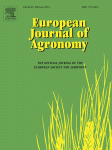Ver ítem
- xmlui.general.dspace_homeCentros Regionales y EEAsCentro Regional Santa FeEEA RafaelaArtículos científicosxmlui.ArtifactBrowser.ItemViewer.trail
- Inicio
- Centros Regionales y EEAs
- Centro Regional Santa Fe
- EEA Rafaela
- Artículos científicos
- Ver ítem
Yield components, light interception and radiation use efficiency of lucerne (Medicago sativa L.) in response to row spacing
Resumen
Lucerne sowing is characterized by a rectangular spatial arrangement, i.e. greater distance between sowing rows than between plants in the row. Therefore, the reduction of row spacing generates more square spatial arrangements that can influence intraspecific competition and resource utilization, especially radiation, and thus biomass. The experiment included different row spacings (10–15–17.5–20 and 30 cm) at the same plant density in a pure lucerne crop
[ver mas...]
Lucerne sowing is characterized by a rectangular spatial arrangement, i.e. greater distance between sowing rows than between plants in the row. Therefore, the reduction of row spacing generates more square spatial arrangements that can influence intraspecific competition and resource utilization, especially radiation, and thus biomass. The experiment included different row spacings (10–15–17.5–20 and 30 cm) at the same plant density in a pure lucerne crop during the first production year. Total aerial dry matter (ADM) was increased by narrow spacing (more square arrangements) up to an optimal distance (around 13 cm) (R2 = 0.60). ADM ranged from 2292 to 1670 g DM m−2 for 15 and 30 cm row spacing, respectively. Plant density was the forage yield component most affected by row spacing and it increased with narrow spacing (0.15 ≥ R2 ≤ 0.5). ADM responses to reduced row spacing were positive as revealed by both a linear increase in radiation interception (PARia) (R2 = 0.76) and an optimal pattern in radiation use efficiency (RUE) (R2 = 0.45). PARia in the first year showed an increase of 8 MJ cm−1 of spacing reduction. RUE values ranged from 2.0 to 1.6 g DM MJ−1 for 15 and 30 cm row spacing, respectively. The leaf area index (LAI) was also affected by row spacing. Additionally, seasonal variation was found for the main variables but did not interact with row spacing. In conclusion, reducing row spacing to an optimal distance is a practice that allows for more favourable spatial arrangements of a lucerne crop and has a positive impact on forage production.
[Cerrar]

Autor
Mattera, Juan;
Romero, Luis Alberto;
Cuatrin, Alejandra;
Cornaglia, Patricia Susana;
Grimoldi, Agustin Alberto;
Fuente
European Journal of Agronomy 45 : 87-95 (February 2013)
Fecha
2013-02
ISSN
1161-0301
Formato
pdf
Tipo de documento
artículo
Palabras Claves
Derechos de acceso
Restringido
 Excepto donde se diga explicitamente, este item se publica bajo la siguiente descripción: Creative Commons Attribution-NonCommercial-ShareAlike 2.5 Unported (CC BY-NC-SA 2.5)
Excepto donde se diga explicitamente, este item se publica bajo la siguiente descripción: Creative Commons Attribution-NonCommercial-ShareAlike 2.5 Unported (CC BY-NC-SA 2.5)

